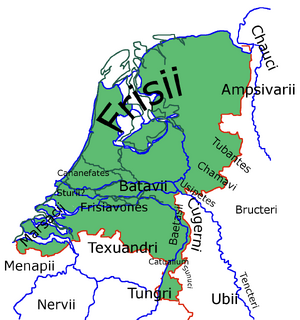Frisiavones
| Author:Laxman Burdak, IFS (R) |

Frisiavones were a Germanic people living near the northern border of Gallia Belgica during the early first millennium AD. Little is known about them, but they appear to have resided in the area of what is today the southern Netherlands, possibly in two distinct regions, one in the islands of the river deltas of Holland, and one to the southeast of it.
Variants
Jat clans
Name
Attestations
The name Frisiavones is only mentioned in one classical text, the Naturalis Historia by the Roman writer Pliny the Elder, published in 77 AD. In Roman-era epigraphy, however, it appears several times.[1][2] The earliest inscriptions referring to the Frisiavones date back to the early 2nd century AD, and are found on votive, funerary and military monuments.[3] Six Roman military diplomas in particular, issued by Roman emperors in Britain in the years 105–178 AD, complemented by five inscriptions found in Roman forts in Britain, mention a cohort named Frisiavonum or Frisiavon.[4]
Besides the purely graphic variation Frisaebones, an o-stem *Fris(i)avi may also be attested in the Matribus Frisavis Paternis and the dative singular Frisao, which is probably an inaccurate spelling of *Frisavo.[5]
Etymology
According to Günter Neumann, the phonology of Frisiavones, the initial f- in particular, suggests a Germanic origin. It is presumed to stem from the tribal name Frisi attached to the suffix -avo-, and may have meant 'those belonging to the Frisii, descending from the Frisii'.[6] However, scholars note that no historical or geographical relation can be established between the Frisii and the Frisiavones apart from the linguistic connection.[7][8]
Geography
The Frisiavones are not listed among the Germani Cisrhenani by Caesar, which suggests that they settled later in the region, possibly invited by Agrippa during the reorganization of the newly conquered lands in northern Gauls during the second part of the 1st century BC.[9] The Roman writer Pliny, who had visited the region in 47 AD, seems to associate the name Frisiavones with two distinct areas.[10] In one passage, he describes the Frisiavones as an ethnic group distinct from the Frisii, and locates them in the islands of the Rhine–Meuse–Scheldt delta, along with Batavians, Canninefates, Chauci, Sturii and Marsaci.[11][12] In another passage, he lists the Frisiavones among the Tungri, Baetasi and Sunuci.[13][14]
Tacitus, writing in the second half of the 1st century AD, divides the Frisii into two groups: the Greater Frisii (maiores) and the Lesser Frisii (minores).[15] Most authors agree that the Frisii were in fact divided among Greater and Lesser, and they generally place the Lesser Frisii in North Holland, and the Greater Frisii in Friesland and Groningen.[16] However, scholars generally reject the identification of the Lesser Frisii with the Frisiavones since the Frisii and Frisiavones were clearly perceived as two distinct groups by Roman writers of the 2nd century AD.[17][18][19]
No specific archaeological culture can be associated with the Frisiavones, and we have no archaeological indication regarding their territory.[20] Based on epigraphic evidence, a number of scholars associate their homeland with the western part of North Brabant, southern South Holland, or Zeeland.[21] One votive inscription from the 2nd century AD refers to the regio frisiavonum as part of Gallia Belgica.[22] Edith Wightman proposed that the borders of Germania Inferior lay west and south of the Meuse rather than around it, thus including the territory of the Frisiavones near the Batavi, Marsaci and Sturii. She mentions one inscription from Bulla Regia that refers to an area comprising the Tungri, Batavians and Frisiavones, and thus stretching over two provinces.[23]
Although the capital of their civitas is not known, they were treated as a separated region and had to pay taxes to Rome, suggesting that the Frisiavones lived in a Romanized society.[24] According to Wightman, the Marsaci and the Sturii could have been pagi (smaller geographical units) within the civitas of the Frisiavones, or else in that of the Menapii.[25]
Culture
The areas usually attributed to the Frisiavones do not match with the regions where 'Frisian' pottery has been found, suggesting that the material cultures of the Frisii and Frisiavones were not related.[26]
The name of a goddess, Matres Frisavae Paternea, found on a votive near Xanten, has been interpreted as related to the Frisiavones, although it could also bear the name of the Frisii.[27]
External links
See also
References
- ↑ Neumann, Günter; Timpe, Dieter (1998). "Frisiavones". In Hoops, Johannes (ed.). Reallexikon der Germanischen Altertumskunde (in German). Vol. 10. Walter de Gruyter. ISBN 978-3-11-015102-2. pp. 83–84.
- ↑ Galestin, M. C. (2007). "Frisii and Frisiavones". Palaeohistoria. 49/50: 687–708. ISSN 0552-9344. pp. 692, 705.
- ↑ Galestin 2007, p. 696.
- ↑ Galestin 2007, pp. 698–699
- ↑ Neumann & Timpe 1998, pp. 82–84.
- ↑ Neumann 1999, p. 113.
- ↑ Neumann & Timpe 1998, pp. 83–84.
- ↑ Galestin 2007, p. 706.
- ↑ Neumann & Timpe 1998, pp. 82–84.
- ↑ Galestin 2007, p. 687, 691.
- ↑ Wightman, Edith M. (1985). Gallia Belgica. University of California Press. ISBN 978-0-520-05297-0. p. 54.
- ↑ Pliny. Naturalis Historia, 4.29 (aka 4.15)
- ↑ Pliny. Naturalis Historia, 4.31 (aka 4.17)
- ↑ Galestin 2007, p. 687.
- ↑ Galestin 2007, p. 688.
- ↑ Galestin 2007, pp. 691–692
- ↑ Neumann & Timpe 1998, pp. 83–84.
- ↑ Rives, James B. (1999). Tacitus Germania. Oxford: Clarendon Press. ISBN 0-19-815050-4. OCLC 40423547. p. 262.
- ↑ Neumann 1999, p. 113.
- ↑ Galestin 2007, p. 694.
- ↑ Galestin 2007, p. 694.
- ↑ Galestin 2007, p. 697.
- ↑ Wightman 1985, pp. 54, 63.
- ↑ Galestin 2007, p. 706
- ↑ Wightman 1985, p. 54.
- ↑ Galestin 2007, p. 694.
- ↑ Galestin 2007, p. 697.

